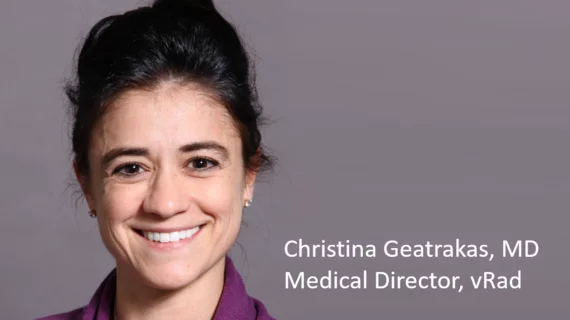Stroke care during a pandemic: vRad medical director talks COVID-19, patient anxiety and more
Since the beginning of the COVID-19 pandemic, hospitals have reported that stroke and heart attack patients are staying home instead of seeking the medical attention they need. Medical societies have warned against such actions, highlighting the importance of seeking treatment, yet the trend continues throughout the United States.
What does this shift mean for patients and patient care? How else has COVID-19 changed the way healthcare providers perform their jobs? We turned to Christina Geatrakas, MD, a medical director at vRad, a MEDNAX company, to find out. She spoke at length about COVID-19, telemedicine and vRad’s AI-powered stroke program.
What do you think about how patients have responded to the ongoing pandemic? Does it surprise you that patients are staying home in the face of such life-threatening conditions?
Just as the pandemic was developing, I started to become concerned about non-COVID-19 medical conditions that were going to be undertreated or untreated due to limited access to care and patients self-restricting their seeking of medical attention. The majority of vRad’s volume comes from emergency departments across the country and we definitely witnessed a troubling decline in emergent studies in March and April. It’s going to be challenging to tally the comprehensive toll of this pandemic, because we must also factor the non-COVID-19 cases that are a direct result of limited access to care and patients not seeking care.
And, no, I’m not surprised that people are staying home—the messaging has been frequent and consistent regarding the seriousness of COVID-19, so it is understandable that the public has been afraid to enter hospitals and emergency rooms for any reason because they fear they could contract the virus. Because most specialties quickly focused on urgent conditions, it has also left outpatient care centers seeing a reduction in patient visits. It isn’t surprising at all, unfortunately.
How else has COVID-19 impacted patient care in the last several weeks? Have you noticed any other big changes?
We learn more about COVID-19 almost daily, and now recognize cases of coagulopathy and vascular damage, leading for example to blood clots in the veins of the legs, the pulmonary arteries, coronary arteries, and arteries of the brain. As this knowledge emerges, it reinforces the importance of people seeking care for stroke symptoms, which may actually indicate Coronavirus infection. This is particularly important in younger people, under age 50, who may be more at risk for developing these vascular complications of the disease.
Also—this is just anecdotal at this point—but in addition to the delayed stroke cases I mentioned earlier, we’re also seeing the care of relatively common diseases such as appendicitis and diverticulitis being delayed as a result of patients attempting to tough it out at home.
I’m also watching the shift to telemedicine that’s taking place. I’ve been a teleradiologist for seven years now and it comes very naturally to me, but I’m interested to see how my clinical colleagues handle working as telemedicine providers; I believe they’ve truly risen to a challenging occasion. I don’t predict that there will be a major shift to telemedicine after the pandemic, but in the short term, it does help provide other specialists with a lot more perspective about what it is like; everyone is experiencing the opportunities and challenges of remote work.
May happens to be Stroke Awareness Month. Can you tell me a bit about vRad’s stroke program?
vRad performs stroke imaging analysis in the scope of diagnostic radiology, partnering with on-the-ground teams providing an interventional scope of care for those patients. We read stroke imaging for every level of accredited stroke center, and our radiologists have extensive experience in brain CT, brain CTA, brain CT perfusion and brain MRI.
Because we cover so many emergency departments across the country, including over 250 certified stroke centers, our neuroradiologists and stroke specialists see a lot of cases. This, combined with the large size of our team, allows us to deliver high-quality interpretations in an incredibly short timeframe.
The program’s average stroke protocol turnaround time is less than seven minutes—how does vRad deliver such fast care with the practice’s specialists all working remotely?
With an eye on the “time is brain” principle, we’ve leveraged our AI and technology platform to dramatically reduce turnaround times for stroke imaging studies. I’ll give you a few examples. All non-contrast CT head images pass through our AI model for ICH and are automatically escalated if hemorrhage is identified as likely, even if the study was not ordered as a “stroke protocol” by the facility. All stroke cases are automatically assigned to all available credentialed radiologists and must be read next. The system also leverages natural language processing within our dictation software, triggering auto-dialed calls to the ordering physician if relevant stroke language is dictated.
The next part of that equation is our deep capacity of radiologists. We have plenty of coverage for sites that use our delegated credentialing process or otherwise privilege all available radiologists.
vRad also utilizes an operations center, which uses both human resources and our automated capabilities to connect our radiologists with stroke teams. Our specially trained staff working in that center are key to facilitating communication whenever needed.
Visit the vRad website to learn more about the Stroke Imaging Service of Excellence.
What is your advice for individuals who experience stroke-like symptoms? Should the pandemic impact their decision-making process?
I strongly urge anyone experiencing stroke symptoms to seek medical care just as they would have prior to the pandemic. And now that we know stroke symptoms may actually indicate Coronavirus infection, it’s more important than ever. Nothing has changed about the seriousness of this potentially devastating neurological condition. The treatments available for these events can save lives—and improve the quality of life—but much of that success depends on interrupting the stroke before there is a significant injury to tissue.

